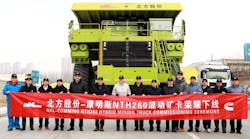|
In a November 2009 public workshop, the California Environmental Protection Agency's Air Resources Board outlined an extension for non-certified engines – from the then deadline of Jan. 1, 2010 – for owners of 25 or less of the 50-horsepower-and-up engines covered under PERP.
|
Then again, clichés by their very nature are based on statements of fact: “It's all the same air we're breathing.”
Edwards, an equipment manager with the privately held heavy-utility contractor Valley West Construction Co. headquartered in Campbell, Calif., was closing out 2009 faced with having to dispose of items he had registered under the statewide Portable Equipment Registration Program (PERP), a years-long journey that itself has left him at times confused, frustrated, humored and angry.
“The slugging trailers will probably go into the scrap heap, and the air compressors will probably be auctioned off and they'll probably end up out of state – which is the other stupid thing: A guy can buy this, take it up to Oregon just the other side of the border, and run it totally free of any restrictions at all,” says Edwards. “It's all the same air we're breathing. It's unfair.”
As of Dec. 31, “simply because the interim time period has expired, we will no longer be able to operate these 12 small items in the state,” Edwards was saying just prior to Christmas. “So, in 2010, we're looking at spending approximately $120,000 just to be able to operate at the same level. The pieces that I'm having to dispose of are still totally good, viable units. They probably on the average have between 1,600 and 2,200 hours on them, and typically we would operate these air compressors until they had in the neighborhood of 7,500 to 8,000 hours. So, we're losing about three-quarters of the useful life, strictly due to a regulation. It isn't, you know, 'When it wears out, you have to replace it with something certified.' This is, 'After such and such a date, this just has to go!'”
Back in the summer of 2008, Edwards had an understanding, albeit frustratingly so, that the scenario just might turn out this way. “You've got to have a certified engine powering, whether it be an air compressor, generator, pump or whatever it is. Well, they either have to be certified or under 50 horsepower,” he was saying then. “About half of my fleet doesn't have certified engines in them, and they're still totally usable air compressors. Probably the average hours on each is between 2,000 and 3,000 hours . . . and that thing's still in the prime of its life.
“I'm all for clean air and everything, but I'm afraid I'm going to starve to death. We're going to be spending everything on equipment.”
Playing in good faith within PERP has made Edwards, at times, feel like a perp. “We were extremely proactive. We signed up early, paid the money and all of that stuff. And then the state, because of the poor response, granted a lot of fleets amnesty, and said, 'Well that deadline really didn't count, so here's a new deadline.' So, they allowed all the people who didn't sign up to actually get away with it,” he says. “In a bid scenario, our prices are higher because of this program, and we have to compete with people who aren't in the program, which gives them an automatic advantage. And here we are trying to be proactive and environmentally conscious, and it makes it really hard. I would have preferred that the state treated everybody the same. You're either in by the 31st or you're out . . . instead of granting extension after extension.”
And the road to clean air just, apparently, keeps finding detours. In a November 2009 public workshop, the California Environmental Protection Agency's Air Resources Board outlined an extension for non-certified engines – from the then deadline of Jan. 1, 2010 – for owners of 25 or less of the 50-horsepower-and-up engines covered under PERP. “I'll quote the state,” Edwards says, and consistently so with a PowerPoint presentation from the workshop that is posted online at the state's PERP website. “The state told me that they are allowing operations of these uncertified engines, which are these 12 that I need to get rid of now. If your fleet is less than 25 units, if you apply they will grant an extension.”
And that opportunity brought up one of the biggest ongoing bones of contention with PERP.
“There again, I posed the question, 'Well, what about the local level?'” says Edwards. “And their answer was that, 'Well, they hoped that the people at the local level understand.' That shows how the left hand is not in sync with the right hand at all.”
PERP walkTo understand PERP's “little local problem,” Edwards takes us back to when he was introduced to the voluntary program.
The various districts throughout the state were, with authority, issuing permits for the legal operation of diesel-powered equipment within their individual jurisdictions, causing administrative nightmares and cost expenditures for fleet managers. “How long would it be in that particular area, and is it there long enough to apply for a permit over there? Or do we need to take it out of this area and move it to another?” recalls Edwards of the daily questions he needed to ask. “So, the state said, 'Well, this portable equipment program will do away with all of that. You just have to have this one number. If you're in the program, that will supersede the requirements that all the local areas had.'
“Well, that's what they said when we signed up. Turns out that is not entirely the case. Now, I think, had I to do this over again knowing what I know now, I probably wouldn't be in the program,” says Edwards. “We haven't had a problem, but now in all of the correspondence that I've had with the state, they are very careful to point out, clearly, that we still do have to comply with not only the state's regulations, but also we have to comply with the people at the local level. And that's exactly what this program was supposed to take away.”
It's all about following the money, he says. “As far as it not being universally recognized, that was I think more a function of the local districts not recognizing it. The people who are in charge of this program don't have any authority over the local districts. Especially with the slowdown in the economy, the local people aren't funded to the extent they used to be, so they are seeking all of the additional funding through fines and such. That is really not the fault of the operators of the state program, although I would have preferred they all got on the same page before they passed the regulations.”
And tempting fate is not a viable option, says Edwards, noting that along with their own mandate and desire to do what's plain right for the world, West Valley and other construction companies in central California operate under the watchful eyes of environmentally conscious residents. “For the state to tell us, 'Well, we hope that they don't make a problem,' there isn't any security in that,” he says, “especially when the local level is starving for funds.”
Back in the summer of 2008, Edwards was considering himself as being fortunate, that he could, as he thought, be out in front of the issue. “This thing is really complex. Fortunately for us, we're big enough and I have enough help around here that I am able to put a lot of time into this thing to truly figure out what is the best course of action,” he was saying then. “I'm sure there are people out there who say, 'Oh well, God, we've got to sell this equipment,' and then come to find out that maybe they should have held on a little bit. They end up hurt even worse.”
About 18 months later, and fast approaching an expiration date for some of his own portable gear “so I've been trying to run the snot out of them here,” he remains optimistic, but in a much less altruistic manner, wise to his PERP experiences. Moving forward, “I think it will be easier. A lot of equipment manufacturers are now putting 49-horsepower engines in the air compressors, so those are exempt.” West Valley Construction's compressors are used to power tools for such preparatory or complementary applications as tearing out sidewalk to reach an underground utility valve, digging in hard soil, and breaking out curb and gutter. “If we had to operate these things eight hours a day, every day, every week, I'd say they'd probably be a little underpowered at 49 horsepower,” says Edwards. “But we operate them on the average less than three to five hours a day, and it isn't three to five hours straight. It's an hour here, 30 minutes there, an hour at the next site, so they have some time to rest.
“So, unless they change the qualifying power rating, we'll be eventually out of the statewide program,” he says with brief relief. “But we'll still have to deal with everything at the local level.”
|




